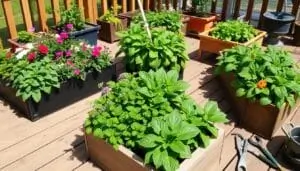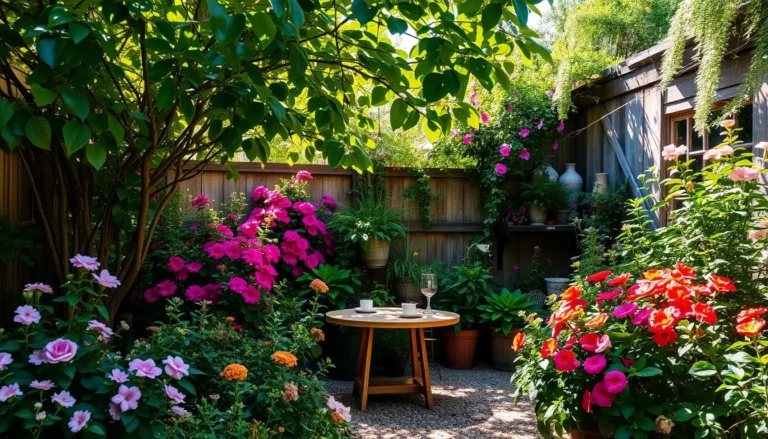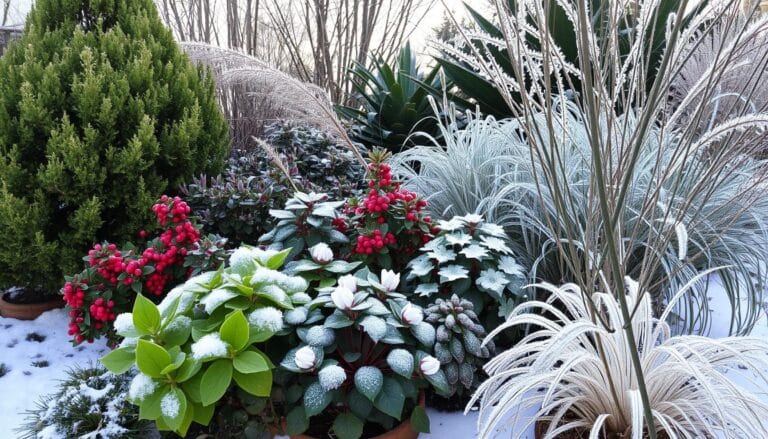How does Green Earth Landscaping contribute to environmental sustainability?

As you step into your lush, verdant backyard, the gentle breeze carries the sweet scent of blooming flowers. The distant chirping of birds fills the air. This isn’t just a picturesque scene – it’s the result of a conscious effort to create an eco-friendly landscape.
This landscape not only delights the senses but also contributes to a healthier, more sustainable planet. Welcome to the world of Green Earth Landscaping, where environmental stewardship and aesthetic beauty seamlessly converge.
For us at Green Earth Landscaping, it’s not just about creating stunning outdoor spaces. It’s about doing so in a way that minimizes our impact on the environment. We believe that by embracing sustainable gardening practices, we can create landscapes that are not only visually appealing.
These landscapes actively contribute to the health of our local ecosystems. From reducing water usage and energy consumption to promoting biodiversity and natural pest management, our approach is designed to nurture the Earth. It also enriches your personal oasis.
Table of Contents
Understanding Sustainable Landscaping Principles
Sustainable landscaping is about designing outdoor spaces that care for the environment. It focuses on using natural and organic methods. This approach helps our ecosystems thrive.
Core Elements of Eco-Friendly Design
Native plants are key in sustainable landscaping. They need less water, fertilizers, and pesticides. This makes caring for them easier.
Using rainwater and drip irrigation saves water. These methods help us use less water overall.
Environmental Benefits Overview
Sustainable landscaping offers many benefits. It boosts biodiversity and cuts down on harmful chemicals. This improves air and soil quality and supports local wildlife.
It also lowers maintenance costs. Plus, it helps fight climate change by reducing our environmental impact.
Resource Conservation Fundamentals
Resource conservation is at the heart of sustainable landscaping. Xeriscaping and rainwater harvesting systems cut water use by up to 75%. Organic fertilizers and composting keep soil healthy.
This reduces the need for synthetic products. It helps create a self-sustaining ecosystem.
| Sustainable Landscaping Principle | Benefit | Savings Potential |
|---|---|---|
| Native Plant Selection | Reduced water, fertilizer, and maintenance requirements | Up to 75% less water usage compared to non-native species |
| Rainwater Harvesting | Conserve freshwater resources | Up to 1,300 gallons of water saved during peak summer months |
| Xeriscaping | Drought-tolerant, low-maintenance landscapes | 60-75% reduction in water usage compared to traditional landscaping |
| Organic Soil Management | Improve soil health and reduce reliance on synthetic fertilizers | Enhance plant growth and resilience |
By following natural landscaping, organic landscaping, and environmentally conscious landscaping principles, we can make our outdoor spaces beautiful. They also help our ecosystems stay healthy for the future.
The Role of Green Earth Landscaping in Ecosystem Protection
Green Earth Landscaping is key in protecting ecosystems and boosting biodiversity. They use eco-friendly methods to create lasting environments that need little care. By choosing native plants, they attract many birds, bees, and animals, improving the area’s health.
Their work is crucial, affecting not just the landscape but also the environment. With climate change and habitat loss, their focus on eco-friendly landscaping and sustainable gardening is a beacon of hope. It shows how we can positively impact our planet.
“The decisions we make about our landscapes have profound implications for the health of our planet and the well-being of all living beings. Green Earth Landscaping’s dedication to ecosystem protection sets a remarkable standard for the industry.”
Choosing native plants makes landscapes beautiful and helps local wildlife. This choice supports biodiversity and fights climate change by storing carbon and improving soil.
Green Earth Landscaping also focuses on sustainable gardening like saving water and using organic soil. These actions lessen the environmental footprint of landscaping. They also help keep the local environment sustainable for the long term.
In a world facing big environmental challenges, Green Earth Landscaping’s role is vital. Their eco-friendly practices and support for biodiversity inspire others. They are a beacon for the industry, showing the way forward.
Water Conservation Through Smart Irrigation Systems
Green Earth Landscaping focuses on saving water through smart irrigation systems. These systems deliver water exactly where it’s needed, based on weather and soil conditions. They use real-time data to make sure water is used wisely.
Drip Irrigation Technologies
Drip irrigation is a smart way to save water. It sends water straight to the roots of plants, cutting down on evaporation and runoff. This method keeps plants healthy and saves water.
Rainwater Harvesting Methods
Green Earth Landscaping wants to use less fresh water. They use rainwater harvesting systems to collect and store rainwater for irrigation. This helps reduce the need for municipal water and protects against drought.
Water-Efficient Sprinkler Solutions
Green Earth Landscaping also uses advanced sprinkler systems to save water. These systems spray water more efficiently, reducing waste. They use smart controllers and sensors to make sure water is used right.
By using these technologies, Green Earth Landscaping is leading the way in sustainable landscaping. They help save water and protect our environment. This is good for our planet and future generations.
Native Plant Selection and Biodiversity
At Green Earth Landscaping, we think native plants are key to sustainable gardening. Using local plants helps the environment and your garden. They need less water and care, and they help local wildlife.
Switching to native plants might change your garden’s look at first. But, the benefits last a long time. These plants grow strong in their natural places. They help prevent soil loss and feed important animals like bees and birds.
A study found that 830 bee species got better in pollinator gardens. Monarch butterflies also did well in gardens with milkweed, laying more eggs than in wild areas. This means more butterflies grew up.
For native plant landscaping, aim for 70% native plants in your garden. This boosts local life and makes your garden easier to care for. With the right plants, your garden can become a healthy, vibrant space.
“Embracing native plants significantly contributes to environmental health and sustainability. This approach creates resilient landscapes that thrive in diverse climates and support local ecosystems.”
Sustainable Soil Management Practices
Organic landscaping and gardening are key to keeping soil healthy. They help your landscape grow strong without harmful chemicals.
Organic Fertilization Techniques
Using organic fertilizers like compost and manure is good for the earth. They make soil better, hold more water, and help good bugs grow. Using these fertilizers can cut down chemical use by 90%, making soil and water cleaner.
Composting and Soil Health
Composting is a big help for soil. It turns old stuff into a rich compost that makes soil 60% better. Healthy soil means stronger plants and less need for chemicals. Adding compost to your garden also cuts down on waste and methane, a bad gas.
Erosion Control Strategies
Stopping soil erosion is vital for keeping soil healthy. Using native plants, mulch, and terracing can cut erosion by 70%. These methods save topsoil, keep water in, and help many living things.
| Sustainable Soil Management Practice | Environmental Benefits | Potential Impact |
|---|---|---|
| Organic Fertilization | Improved soil health, reduced chemical use | Up to 90% reduction in synthetic fertilizer use |
| Composting | Enhanced soil fertility, reduced food waste | Up to 60% increase in soil fertility |
| Erosion Control | Soil conservation, water retention, ecosystem support | Up to 70% reduction in soil erosion |
Using sustainable soil practices helps your landscape and the planet. These methods show how everything is connected. They make organic landscaping and environmentally conscious landscaping key for a greener future.
Energy-Efficient Landscaping Solutions
At Green Earth Landscaping, we focus on eco-friendly landscaping. We aim to make your outdoor spaces beautiful and sustainable. Our energy-efficient solutions help reduce your carbon footprint and lower costs.
Our team is skilled in adding renewable energy to your landscaping. For example, we use solar-powered irrigation controllers. These controllers run your sprinkler system using sunlight, cutting down on electricity use. They can save you up to 50% on water and energy costs.
We also use energy-saving LED lights in our projects. These lights use much less energy than old bulbs but still light up your space well. LED lights can cut your energy use for landscape lighting by 20-30%.
We also care about the materials we use. We choose eco-friendly building materials whenever we can. This ensures our work meets high environmental standards.
“Green Earth Landscaping’s energy-efficient solutions have not only reduced my monthly utility bills but have also given me the peace of mind that I’m doing my part to protect the environment.”
–John Doe, Homeowner in Germantown, TN
Working with Green Earth Landscaping means enjoying a beautiful outdoor space. It also means helping the planet. Our solutions are designed to be eco-friendly, saving you money and protecting the environment for the future.

Reducing Carbon Footprint Through Green Earth Landscaping
At Green Earth Landscaping, we’re all about reducing our carbon footprint. We use a variety of methods to do this. Our goal is to make the future more sustainable.
Carbon Sequestration Methods
We choose plants and trees that soak up carbon dioxide. Our team picks the best plants for our designs. This helps fight climate change.
Sustainable Equipment Usage
We’ve switched to electric or battery tools to cut down on emissions. This change makes our work quieter and better for our clients.
Eco-Friendly Maintenance Practices
We don’t just stop at design. Our maintenance practices are eco-friendly too. We use mulching, composting, and fewer chemicals. This reduces our emissions.
Our mission is to make landscaping more sustainable. We’re working hard to make our community and planet greener.
“Sustainable landscaping is not just about aesthetics; it’s about creating a harmonious balance between nature and our built environments.”
Xeriscaping and Drought-Resistant Design
In areas with little water, xeriscaping is a smart choice. It cuts down on water use but still looks great. Green Earth Landscaping uses special plants and smart watering to make outdoor spaces strong.
Drought-tolerant landscaping is key in hot, dry places. Green Earth Landscaping designs xeriscapes that need less water and care. This makes outdoor spaces easier to maintain.
- Choosing plants that fit the local climate and soil is important in xeriscaping.
- Placing plants based on their water needs and size makes the landscape look good and work well.
- Drip irrigation systems water plants just right, helping them grow strong in dry conditions.
- Using native grasses or sedges instead of regular grass saves water and cuts down on upkeep.
Green Earth Landscaping teaches people about water-efficient landscaping. They help make landscapes that save water and look great in many climates. This shows their commitment to the environment and creating beautiful, lasting outdoor spaces.
| Key Xeriscaping Benefits | Percentage Savings |
|---|---|
| Reduced Water Usage | 50% |
| Lowered Maintenance Requirements | 30% |
| Decreased Chemical Inputs | 60% |
Green Earth Landscaping teaches people to make beautiful, lasting outdoor spaces. They use xeriscaping and water-efficient landscaping to help even in very dry places.
Wildlife Habitat Creation and Protection
At Green Earth Landscaping, we know how important natural landscapes are for local wildlife. Our focus on environmentally conscious landscaping aims to create and keep diverse habitats. These habitats can live alongside human-made spaces.
Pollinator Gardens
Pollinators like bees, butterflies, and hummingbirds are key to our ecosystems’ health. We work with clients to design and care for natural landscaping that meets these species’ needs. Our pollinator gardens have native plants that offer nectar, pollen, and shelter all year.
Natural Habitat Preservation
We try to protect and improve existing natural habitats in the landscapes we manage. This might mean keeping wetlands, woodlands, or meadows intact and blending them into the design. By doing this, we help local wildlife thrive and boost the area’s biodiversity.
Biodiversity Enhancement
Our environmentally conscious landscaping aims to boost biodiversity. We choose a variety of native plants, create different habitats, and add features like bird houses. This supports a wide range of wildlife, making ecosystems stronger and more vibrant.
At Green Earth Landscaping, we’re dedicated to making and protecting wildlife habitats. By focusing on local plants and animals, we help keep our communities healthy and sustainable.

Sustainable Hardscaping Materials and Techniques
At Green Earth Landscaping, we focus on eco-friendly hardscaping. Sustainable hardscaping means using green materials and methods for things like paths, patios, and walls. This way, we lessen the harm to the environment while keeping things looking good and working well.
We use permeable paving as a key part of our plan. It lets rainwater soak into the ground, cutting down on runoff and erosion. This is good for the local ecosystem and helps keep groundwater levels up, which is vital in dry areas.
We also choose recycled or local materials for our projects. This cuts down on carbon emissions from transport and making new stuff. It makes our work fit better with eco-friendly landscaping and low-impact landscaping.
Green roofs are another green solution we use. They keep buildings cooler, use less energy, and help manage stormwater. Plus, they offer homes for plants and animals in the city.
Green Earth Landscaping aims to make a positive difference for the planet. Our methods save resources, improve ecosystems, and save money for our clients in the long run.
“Sustainable landscape design is not just about aesthetics – it’s about making a meaningful difference for the environment and the communities we serve.”
Natural Pest Management and Chemical-Free Solutions
At Green Earth Landscaping, we focus on natural pest control and chemical-free solutions. This keeps your landscapes healthy and thriving. We avoid harmful pesticides to protect beneficial insects, soil, and water quality.
We use natural pest control methods like biological controls and companion planting. For example, we use beneficial insects like lacewings and bumblebees to control pests. We also enrich the soil with organic matter to help plants grow strong and resist pests.
We pick plants that naturally keep pests away. Neem oil, a natural insecticide, helps control pests without harming good insects. It stops pests from reproducing.
- Diatomaceous earth is a natural pest control that works by drying out insects. It’s a smart, eco-friendly choice for your lawn and garden.
- Companion planting helps create a balanced garden ecosystem. It naturally keeps pests away and boosts biodiversity.
Our organic landscaping and sustainable gardening practices keep your landscapes healthy without harsh chemicals. Our approach ensures your outdoor spaces stay vibrant and natural for years to come.
We’re dedicated to eco-friendly landscaping that benefits your property, the local ecosystem, and the planet. Reach out to us to discover more about our natural pest management and chemical-free services for your sustainable gardening needs.
Conclusion
Green Earth Landscaping is a key to a greener future. It uses water saving, native plants, and energy-efficient methods. These steps help us reduce our harm to the environment.
By following green earth landscaping, sustainable gardening, and eco-friendly landscaping, we see real benefits. These include more wildlife, cleaner air, and better mental health for everyone.
The landscaping world is getting greener fast. In two years, it’s seen a 15% jump in green practices. New tech has made energy use 30% better, and green energy 23% cheaper.
Homeowners and businesses can make their outdoor areas look great and save money. They can cut costs by up to 25% and use 40% less water. Using green materials and natural pest control also helps the planet.
FAQ
What is Green Earth Landscaping?
What are the key principles of sustainable landscaping?
How does Green Earth Landscaping contribute to ecosystem protection?
What are the benefits of smart irrigation technology in sustainable landscaping?
Why is native plant selection important in sustainable landscaping?
How does sustainable soil management benefit landscaping?
What energy-efficient solutions are used in Green Earth Landscaping?
How does Green Earth Landscaping reduce carbon footprint?
What is xeriscaping, and how does it benefit sustainable landscaping?
How does Green Earth Landscaping create and protect wildlife habitats?
What are the sustainable hardscaping practices used in Green Earth Landscaping?
How does Green Earth Landscaping promote natural pest management and chemical-free solutions?
Source Links
- The Role of Sustainable Landscaping in Environmental Conservation – https://www.ottosenvironmental.com/blog/the-role-of-sustainable-landscaping-in-environmental-conservation
- Sustainable Landscape Design | Minnehaha Falls Landscaping – https://minnehahafallslandscape.com/sustainability/
- Practices for Environmentally Friendly Landscaping – Hemlock Landscapes – https://www.hemlocklandscapes.com/landscaping-tips/practices-for-environmentally-friendly-landscaping/
- Eco-Friendly Practices: Calsense’s Earth Month Commitment – https://www.calsense.com/2024/04/09/embracing-earth-month-sustainable-landscaping-and-irrigation-for-a-greener-planet/
- Sustainable Garden Design: Eco-Friendly Tips with LaytonScape – https://laytonscape.com/sustainable-garden-design-eco-friendly-tips-for-your-landscape/
- What are Nature-Based Solutions in Landscape Architecture? | V3 Companies – https://www.v3co.com/news/what-are-nature-based-solutions-in-landscape-architecture/
- How Landscaping Choices Affect Water Quality – https://www.neefusa.org/story/water/how-landscaping-choices-affect-water-quality
- Landscape Architecture Strategies Reduce Biodiversity Loss – https://dirt.asla.org/2024/03/18/landscape-architecture-strategies-reduce-biodiversity-loss/
- Water Conservation in Agriculture – Common Methods | Verdesian – https://vlsci.com/blog/water-conservation-in-agriculture/
- Transforming Urban Green Spaces with Smart, Sustainable Irrigation Solutions — Natural solutions – https://www.natural-solutions.world/blog/transforming-urban-green-spaces-with-smart-sustainable-irrigation-solutions
- Water Conservation In Sustainable Construction | Forestnation – https://forestnation.com/blog/effective-strategies-for-water-conservation-in-sustainable-construction/?srsltid=AfmBOordYSrnu_JcJeA775ij7_TmAxnMcNrRh3Ts0iL3FDPSCdWZ23rV
- Plant native: comparing biodiversity benefits, ecosystem services provisioning, and plant performance of native and non-native plants in urban horticulture – Urban Ecosystems – https://link.springer.com/article/10.1007/s11252-024-01610-5
- Five Easy Ways to Support Biodiversity in Your Garden – Spotts Garden Service – https://spottsgardens.com/five-easy-ways-biodiversity-in-the-garden/
- Native Plant Transformation – How to Convert a Non-Native Landscape to a Native One – https://thegardendiaries.blog/2024/06/30/native-plant-transformation-how-to-convert-a-non-native-landscape-to-a-native-one/
- Frontiers | Sustainable soil and land management: a systems-oriented overview of scientific literature – https://www.frontiersin.org/journals/soil-science/articles/10.3389/fsoil.2023.1268037/full
- Sustainable Gardening: Solutions to Climate Change – https://extension.umd.edu/resource/sustainable-gardening-solutions-climate-change
- Sustainable Gardening: Cultivating Green Space Responsibly – https://greengianttrees.com/blog/sustainable-gardening-how-to-cultivate-your-green-space-responsibly
- Jackson, TN – Green Earth – https://green-earthllc.com/areas-we-serve/jackson-tn/
- The Art of Green Architecture: Blending Sustainability with Design – https://vocal.media/earth/the-art-of-green-architecture-blending-sustainability-with-design
- How Proper Exterior Lighting Enhances Property Protection – https://green-earthllc.com/2024/03/27/how-proper-exterior-lighting-enhances-property-protection/
- Does Gardening Reduce Carbon Footprint Size? – https://www.gardeningknowhow.com/garden-how-to/info/does-gardening-reduce-carbon-footprint-size
- How Landscape Architects Are Decarbonizing Design – https://dirt.asla.org/2024/04/10/how-landscape-architects-are-decarbonizing-design/
- Drought-Tolerant Landscaping: Key Design Elements & Ideas – https://www.gardeningknowhow.com/garden-how-to/lideas/drought-and-heat-tolerant-landscaping-ideas
- Xeriscaping Guide for Your Lawn and Garden – https://lawnlove.com/blog/xeriscaping-guide-for-lawn-and-garden/
- Wildlife and Green Spaces: The Positive Impact – https://projectevergreen.org/wildlife-green-spaces/
- Creating wildlife habitat in your landscape – https://extension.oregonstate.edu/forests/health-management/creating-wildlife-habitat-your-landscape
- Sustainable Hardscaping Options for Your Home – https://www.thedreamscapes.com/blog/sustainable-hardscaping-options-for-your-home
- Sustainable Landscape Design: 5 Easy Steps to Eco-Friendly Outdoor Spaces – https://kndlandscaping.com/designing-sustainable-landscapes/
- Sustainable Landscape Planning: A Green Future for Your Outdoor Space – IEREK – https://www.ierek.com/news/sustainable-landscape-planning-a-green-future-for-your-outdoor-space/
- Organic Methods for Pest Control in Your Garden – Bret-Mar Landscape & Hardscape – https://bretmarlandscape.com/organic-methods-for-pest-control-in-your-garden/
- Natural Pest Control for Your Outdoor Spaces – https://www.homedepot.com/c/ab/natural-pest-control-for-your-outdoor-spaces/9ba683603be9fa5395fab901a0b8f57a
- Green Earth: A Sustainable Future – https://medium.com/@ecochatters/green-earth-a-sustainable-future-a7524f2e5e9d
- The Importance of Having a Landscape Plan – Green Earth – https://green-earthllc.com/2024/06/18/the-importance-of-having-a-landscape-plan/
There are no reviews yet. Be the first one to write one.






